Very briefly and irresponsibly discussed in this post: 15 books (Theories of Ideology; Self Defense; The Soul at Work; When the Sun Bursts; Missing Out; Against Health; Fen, Bog & Swamp; Breasts; Circe; Dom Casmurro; Selected Poems; Customs; Hotel Oblivion; My Wicked Wicked Ways; and Mandela and the General); 3 movies (Barbie; The Last Voyage of the Demeter; and The Lost Daughter); and 3 documentaries (Golden Dawn Girls; Depp v. Heard; and For Sama).
Books
1. Rehmann, Jan. Theories of Ideology: The Power of Alienation and Subjection (2013).
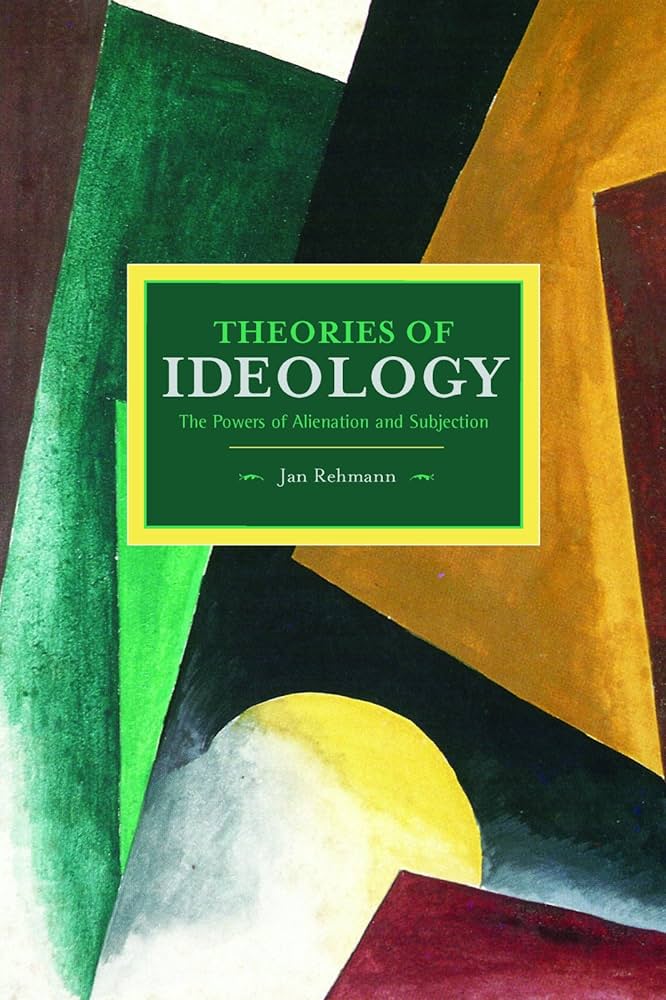
As Jan Rehmann demonstrates, we are not all talking about the same thing when we talk about “ideology.” A crass Marxist approach makes the ideological an epiphenomenon of the economic (think the whole base/superstructure thing). A critic still rooted in Enlightenment views on reason, objectivity, and Truth, might argue that ideology makes people believe false things about the world and themselves. A post-whatever Leninist (Žižek comes to mind here), would argue that any system of belief is ideological. Those who track Weber via Althusser are more inclined to see the ideological as related to technology and State-based apparatuses. Foucauldians would argue that a discursive analysis of the dispositifs involved in the relational and capillary spread of power makes any study of ideology passé (and, perhaps, déclassé!)—even though Foucault himself ends up proposing an ethics of self-care that fits remarkably well with the homo oeconomicus celebrated by neoliberalism. Rehmann understands all of these perspectives, where they overlap, where they contradict each other, how they have all developed, and what strengths and weaknesses each perspective holds. His work continues to be some of the most exciting, intelligent, and also accessible* theory I have read in years (*accessible if you already have some familiarity with his sources; in many ways, I think Rehmann is a true scholar’s scholar—not because he writes in an esoteric manner [like the Branch Derrideans] but because his breadth of knowledge is astounding and is presented in a way that encourages rather than discourages comprehension).
Rehmann then draws on all of these perspectives and incorporates the work of those (like himself) involved in the German ‘Projekt Ideologietheorie” (PIT) to argue that ideology be technically defined as the structural alienated socialisation imposed from above. For Rehmann, ideology theory is about exploring the powers, apparatuses, practices, rituals, and thought-forms that the ruling classes deploy (not always in the same way, not always in agreement amongst themselves) in order to achieve a state of hegemony wherein the ruled classes act against their own best interests and do what is best for the ruling classes. Of course, socialisation from above is never the only form of socialisation people experience (and socialisation from above is never just a singular thing as I just observed), and so when looking at why people act in a certain way and not other ways, other socialisations, other dynamics, other relationships, and other contextual, local, and temporal factors must always be considered. Rehmann does an excellent job of exploring these things. If you want to read some heavy but accessible theory, I highly recommend this book.
2. Dorlin, Elsa. Self Defense: A Philosophy of Violence (2022 [2017]).
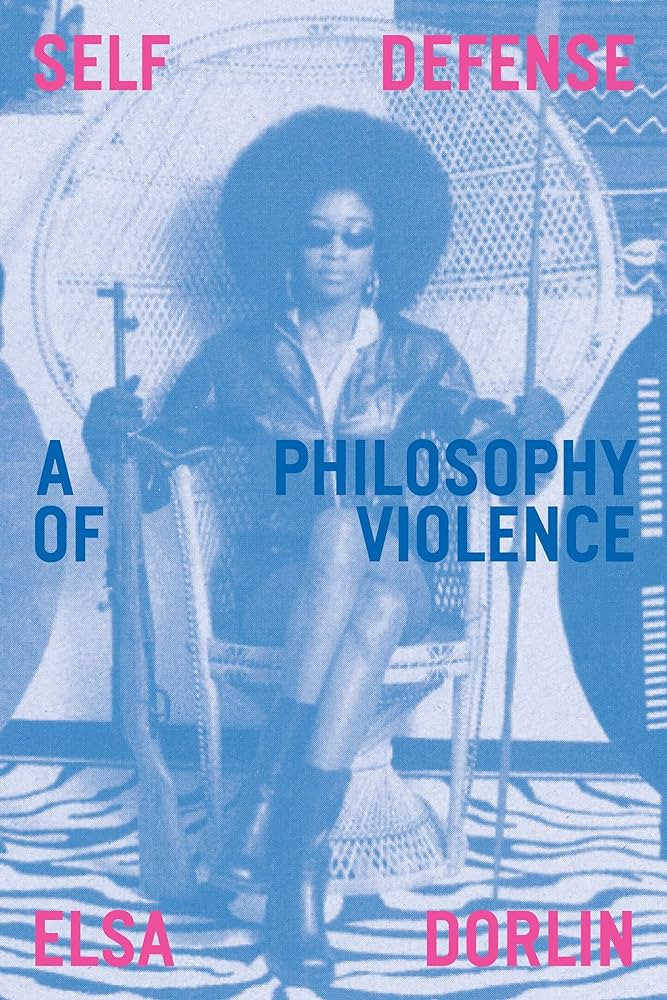
What role does violent self defense have when the overwhelming forces of oppression have always communicated—often through torture, degradation and horrendous abuse—that that more you defend yourself, the more painfully you will die? What role does resistance play when we are taught that “to resist is to be defeated?” For this is the message that oppressors want the oppressed to internalize: you must annihilate the part of yourself that is capable of self defense. This produces subjects who are taught to defend themselves by destroying themselves—i.e. who just barely survive by never fighting back.
This, then is the initial framework Elsa Dorlin establishes for her examination of violent self defense. She distinguishes this from what she describes as “legitimate self defense,” which is the kind of violence that is sanctioned by the State (she does not mean that this is morally legitimate, but rather that it is State-sanctioned). State sanctioned violence comes primarily by two means: through what is legally permitted (police beating unarmed Black people, for example, while urging them to “stop resisting”), but also through what the State implicitly accepts by not prosecuting those who practice it (i.e. the violence of White vigilantes that amounts to “a license to kill”). In this context, especially when one’s life is at risk, Elsa Dorlin argues that physical violence, practiced by the oppressed, is “a vital necessity, a praxis of resistance.” She then traces this through various struggles—first through the ways in which sovereign power posits some people as always already guilty if they arm themselves (Black folx, women, etc.), then by looking at various liberation struggles (notably, the Suffragettes, the Warsaw Ghetto Uprising, the Black Panther Party, various struggles for Queer liberation, and the Combahee River Collective and intersectional feminism). It’s a well done text and, on this subject, I am already a very sympathetic reader. However, I do wish she had spent a bit more time at the end bringing her various threads and streams of though together.
3. Berardi, Franco “Bifo.” The Soul at Work: From Alienation to Autonomy (2009).
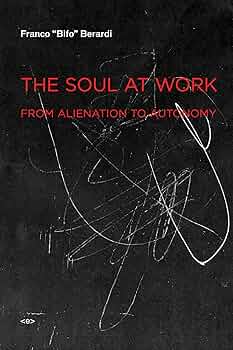
According to Marx, industrial workers are alienated from their true human nature when they are reduced to performing mindless and demanding (mostly physical) labour in mines and mills and factories. Thus, alienation is a wound in the soul of the worker. However, according to Bifo Birardi, and others from the Italian Autonomia Operaia movement, alienation is actually the pathway to liberation because it reveals to the worker the violence, futility, and absurdity of global capitalism and should (in this theory) then lead workers to organize themselves in such a way that they are able to move from poverty to wealth. By “wealth” Birardi does not mean the accumulation of money, possessions, or capital. He refers to wealth as a category of time. Workers are impoverished under capitalism—and most especially under the current iteration of neoliberal austerity and the gig economy—largely because they do not have time for anything but working for wages. To be rich is to have enough free time to engage in activities one enjoys, to rest, to play, to flourish together with others, and so on.
Anyway, this is essentially Berardi’s core thesis although he also gives his perspective on the Marxist and post-Marxist and anti-Marxist (especially Foucault and then also the anti-Foucauldianism of Baudrillard) perspectives. It’s a decent enough text although, at this point, a lot of what I’m reading in this domain of theory is starting to feel repetitive.
4. Bollas, Christopher. When the Sun Bursts: The Enigma of Schizophrenia (2015).
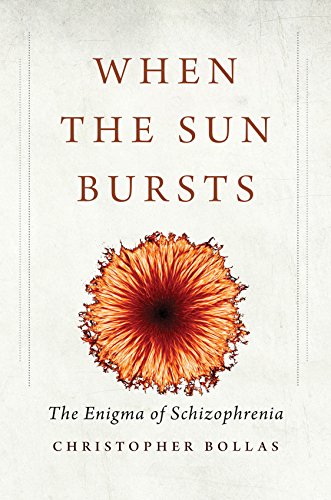
Christopher Bollas is the psychoanalyst whose work most fascinates me at this time. Having read some of his more generally-oriented works, I chose to deep-dive into this specific text about his approach to schizophrenia (which is more of the story of how his approach to schizophrenia has evolved over time, and which is heavily dependent on examining case studies). Bollas argues that, during our formative childhood years, we are exposed to situations whose complexity overwhelms us. Not only that, but the complexity of our own thoughts threaten to overwhelm us at those times and so, in order to be “successfully normal,” we learn to “dumb ourselves down.” When the defenses we erect to protect ourselves from our own mental complexity collapse, schizophrenia can occur. Bollas is emphatic that such schizophrenic outbreaks (or inbreaks) are treatable but, over time, and especially if schizophrenics are treated with medications (and hospitalizations) that essentially turn them into zombies, treatment (to the point of cure) can become increasingly difficult or impossible. A person and their symptoms, Bollas reminds us, are often inseparable. Eradicate a symptom and you might, in fact, eradicate a core component of that person. Instead, Bollas urges intensive psychotherapy during the early stages of an schizophrenic onset and, as he demonstrates from his case studies, when this is done well, it is not uncommon to see patients return to non-psychotic functioning. Again, we see critical differences between how psychotherapy (or at least some schools of psychotherapy) and psychiatry (which dominates community based mental health programs across North America) treat people, understand illness, and work towards wellness.
5. Phillips, Adam. Missing Out: In Praise of the Unlived Life (2012).

It has been said that the unexamined life is not worth living but Adam Phillips wants to know if the unlived life is worth examining. By this, Phillips means that our mental life is as much about the lives we fantasize about living as it is about the life we actually live. We constantly live in-between the lives we want to have and the life we actually have. Thus, our unlived lives, our fantasies, are an essential part of us. According to Phillips, examining this nexus moves moving into the study of desire and frustration—because it is frustration that helps us understand what we want, if we really want what we think we want, what we don’t want, if we really want what we don’t want, and what we don’t know we want or don’t want. In fact, it may well be that our desire to terminate our feelings of frustration (by thinking we know what we want, by trying to gratify this or that desire), may be what prevents us from actually figuring these things out. It also becomes a means of remaining as we are (if we already know what we want then we don’t have to change). Consequently, fantasies also relate to what we think we know about ourselves and reality and frustration may be what happens when fantasies don’t align with the Real (to borrow Lacan’s term). This is why, Phillips argues, knowing so often has little to do with loving and why it is often so difficult for lovers to be able to explain why they are so deeply in love with their partner (which, of course, also relates to Freud’s remarks on sexuality, trauma, and what we seek to know or not know).
Anyway, this is just a glimpse of the creativity and insights Phillips offers in his work. Although I find him a bit heavy on the Shakespeare (I mean, he is British…), I like the way he inspires me to ask fun questions, and to be more creative and playful with the connections I make as I reflect upon the world and me. Good times.
6. Metzl, Jonathan M. and Anna Kirkland (eds.). Against Health: How Health Became the New Morality (2010).
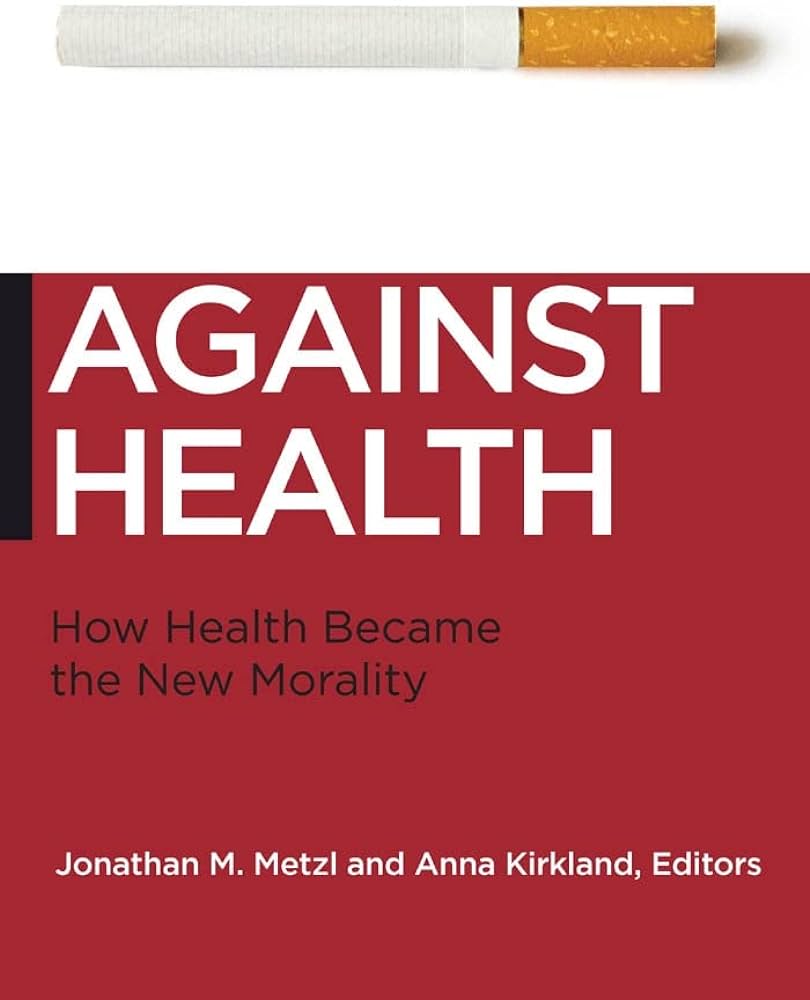
I have long said that the discourse of health has replaced the discourse of religious morality as the justification used by the State to intervene forcibly into the lives of those whom it considers deviant. I’m not alone in saying this. There’s a whole body of critical scholarship that exists around this claim. It’s pretty solid. This collection of essays edited by Metzl and Kirkland adds to that scholarship in a fairly accessible way. As with most essay collections it’s a mixed bag. The real gem here is Lauren Berlant’s essay about obesity and how the pleasure of doing things that are detrimental to our physical health may sometimes be the best thing we can do to improve our mental health. This observation then also changes the snobbish views that people hold about people who engage in various “vices” (from binge eating to smoking to injecting opioids). After all, while it has always been true that the rich will hoard both goods and goodness, how that is expressed changes over time. Currently, the rich hoard good health as a part of their goodness. So, of course, if we want to be healthier we have to do something about rich people. You don’t solve the adverse health impacts of poverty by treating extreme poverty as the problem. Extreme poverty is only a symptom of extreme wealth. Treat that problem, and everyone would be healthier.
7. Proulx, Annie. Fen, Bog & Swamp: A Short History of Peatland Destruction and Its Role in the Climate Crisis (2022).
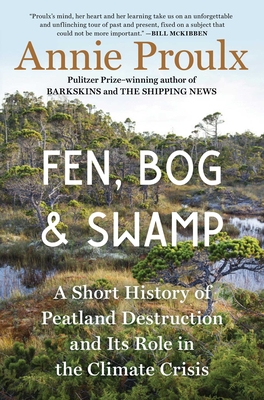
I was almost certainly too young to appreciate what Annie Proulx was doing in The Shipping News when I read it all those years ago but, at that time, I felt like her manner of writing did not connect with me. I lumped her in with authors I consider to be generally overrated in the domain of Canadian literature (i.e., authors who get a lot of praise in Canada simply because they are Canadian and might have had a clever idea or two). However, she wrote that novel years ago (1993!) and her recent literary reflection on fens, bogs, and swamps, garnered a lot of critical praise. So I decided to check it out. It was a pleasurable read (as much as reading anything about the climate crisis can be considered pleasurable) and I learned a great deal.
8. Williams, Florence. Breasts: a natural and unnatural history (2012).

I love science. This was a great science book. Evolutionary biology, microbiomes, and organism-environment dynamics are all presented here in an informed but readable and often humourous way (Williams eviscerates patriarchal understandings of breasts which are rooted in the totally outdated and wrong but persistent idea that breasts evolved because men think they are sexy, and she did this in a way that made me lol several times). So, hey, if you’re interested in an area of complex and evolving science that actually touches on a number of general scientific themes that are quite fascinating, this is a good book for you.
9. Miller, Madeline. Circe (2018).

Witches and hawks seem to be popping up in my life a lot these days so I thought maybe it would be fun to finally read Madeline Miller’s retelling of the story of Circe (whose name means hawk). Miller has made a name for herself by creating contemporary retellings of ancient Greek literature. This feels a bit gimmicky to me (in a smart and very marketable way), but I suspended my snobbery and dove into this imaginative reconstruction of the story of the witch whose legend is foundational for a lot of subsequent witchery. I found the story to be entertaining in a popular fiction kind of way. The story is well-crafted and pulls you through the narrative from start to finish (books that are “real page-turners” are more about the techniques used to get the reader to continue reading the next chapter—just like horror movie directors use certain techniques to create jump scares and, even if you can identify when those techniques are deployed, you may well still jump when the scare happens—and, fwiw, this is a real page-turner). However, when it comes to limited reading time, I think I’d rather focus on other kinds of lit.
10. de Assis, Machado. Dom Casmurro (1991 [1900]).

I’ve been getting more into Brazilian literature and Joaquim Maria Machado de Assis is considered one of Brazil’s best classic authors. He is incisive in his critical observations but all his work is suffused with wittiness. He reminds me of an old professor I had who never lost the twinkle in his eyes and who was always making little jokes (mostly to himself but also to any others who picked up on them). I found Dom Casmurro to be a decent novel. It plays with the novel structure in a way that reminded me of Laurence Sterne—fun and definitely innovative at the time but, perhaps, something that has been more fully developed since then.
11. Tsvetaeva, Marina. Selected Poems (translated and introduced by Elaine Feinstein {1993]).
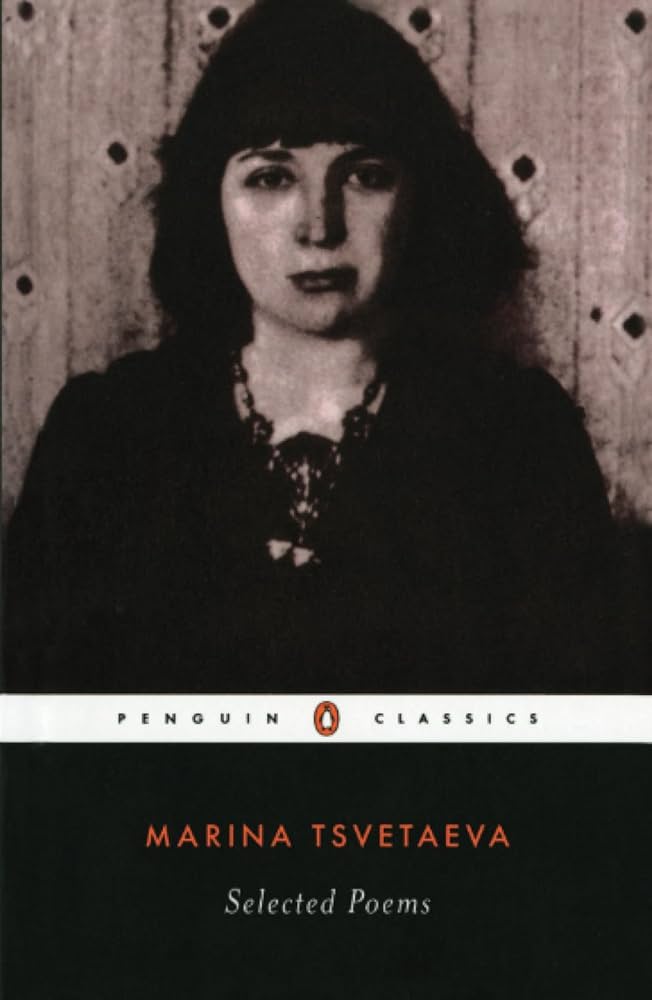
I find that Russian poets are especially difficult to read in translation. Not that I’m fluent in Russian but whenever I read the Russian greats, I mostly find myself thinking things like, “Huh… I feel like I’m missing something here.” And “Huh… how long ‘til I’m done this?” Which is how I felt reading this collection. Huh.
12. Sharif, Solmaz. Customs: Poems (2022).

It’s hard to describe what makes a great poetry collection great. As with any kind of art, so much of what we take from poetry is related to what we bring to it. The pleasure or pain it causes (and Solmaz Sharif’s collection will almost certainly cause both), is highly dependent on the past experiences of the reader and the kind of thing that just resonates with them. What makes you gasp with unexpected joy? What words make you feel like you were kicked in the guts and leave you asking for more? It’s hard to know until you encounter them. I encountered them in Customs. Recommended.
13. Cruz, Cynthia. Hotel Oblivion (2022).
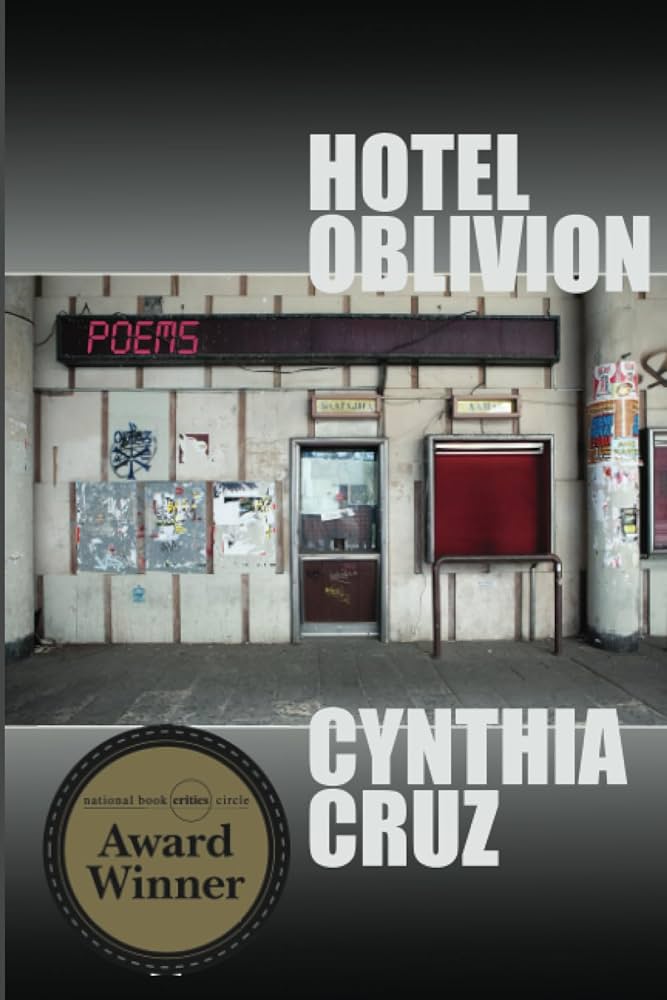
Cynthia Cruz’s work, The Melancholia of Class, is a fantastic piece for those who find themselves in a place of class dissonance (specifically, those who may have left impoverished communities and shit jobs for better pay and a better place to live but who find themselves still trying to remain loyal to those whom they have, in one way or another, left behind). I resonate with it quite a lot. Since reading it, I have tried to engage her poetry a few times and Hotel Oblivion is her latest poetry collection. She wrote it in hotels while traveling in a rather isolated state on a speaking tour in eastern Europe. I didn’t find it particularly inspiring.
14. Cisneros, Sandra. My Wicked Wicked Ways (1987).

Now this is some rad poetry! Sandra Cisneros wields her poems like a straight-razor in the hands of sex worker (Salve Maria das Sete Navalhas!). Brilliant, cutting, hilarious, sexy, unapologetic, rough—this collection is a gift to those who are familiar with the kind of world Cisneros comes from and it is an even bigger gift to those who are not familiar with that kind of world. Highly recommended.
15. Carlin, John and Oriol Malet. Mandela and the General (2018).
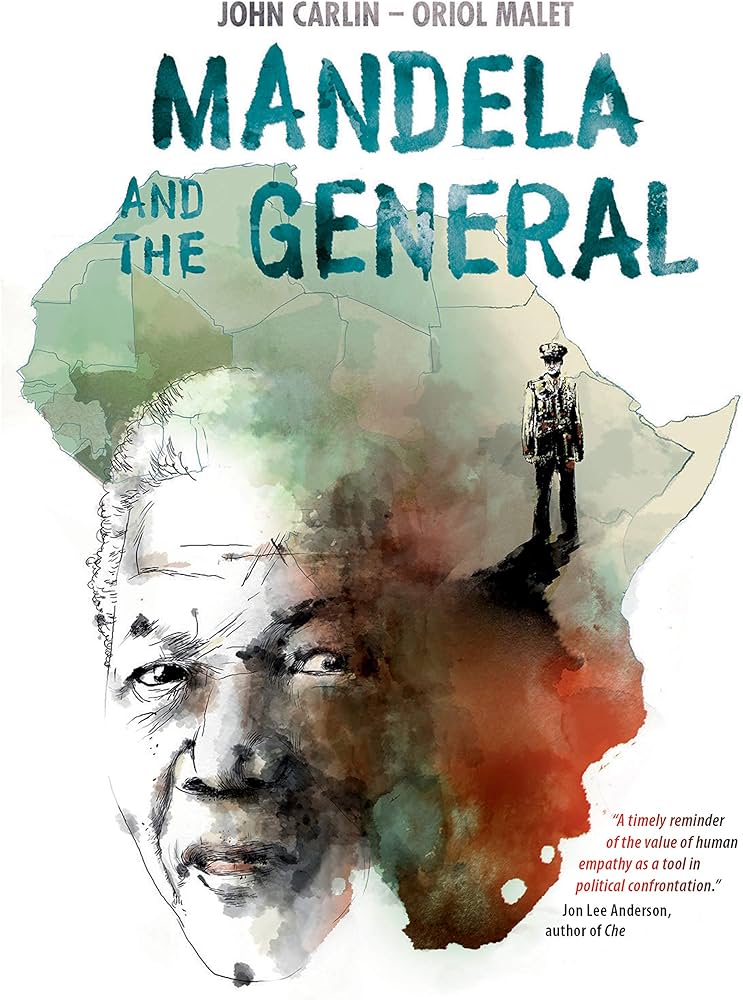
There is a cult that has accumulated around Nelson Mandela and the South African Truth and Reconciliation Commission. However, I believe that this is largely the case because South Africa provided other genocidal nations (Canada, Argentina, Chile, Sierra Leone…) with a template to posture as though change is being created while, in fact, that same people are continuing to hoard wealth and the some other people are still forcibly deprived of, well, mostly everything (for example, White are richer in South Africa and Blacks are poorer in South Africa than before the end of apartheid).
Anyway, I was thinking about this while reading this graphic novel about how Mandela won the respect of a White supremacist general who could have headed up a military coup to try and overthrow Mandela at the beginning of Mandela’s reign. According to Carlin and Malet, Mandela ever only made right and wise decisions after he was released from jail (where, so the mythos goes, Mandela transcended his earlier commitment to violent revolution and ascended to a state of existence similar to Boddhisatva), and so Mandela is presented as one who is so transcendent that he even brings good out of the General. It’s a pretty story. The pictures are great. I’m not sure I buy the myth though. I think Blacks on South Africa lost during the TRC that happened there, I think they are still losing today, and I think this has not set the trajectory for Indigenous peoples in Canadian-occupied territories (and elsewhere) to lose while being told they are winning.
Movies
Gerwig, Greta. Barbie (2023).
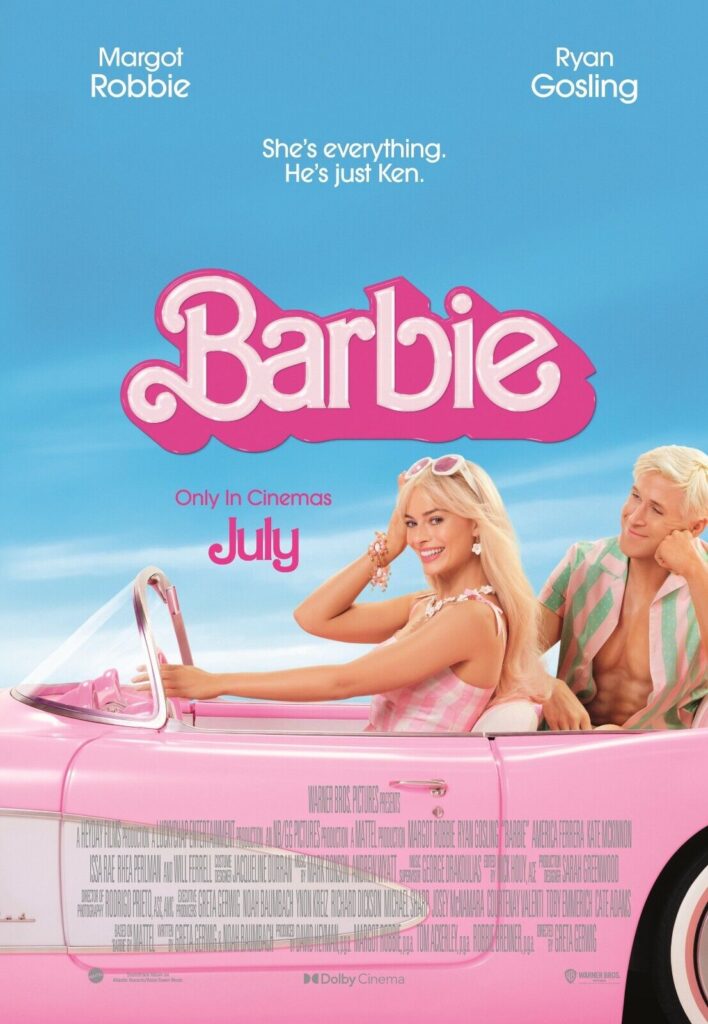
I know that fast food is problematical for all kinds of reasons but every now and again I take pleasure in eating it. It’s probably not great for my physical health, it contributes (a few dollars) towards a corporation that causes great harm in the world, and it’s delicious and these rare moments contribute to my overall quality of life. Do I feel like I need to change my behaviour? Nah.
Watching Barbie is a lot like indulging in fast food at the moment when your craving peaks. It’s sooooo fun. Is it problematical? Sure. For the reasons listed by the bro-trolls? No, of course not. More for the ways in which it functions as a giant advertisement for Mattel, erases Barbie’s actually history of influence on women, girls, and patriarchal society more generally, and does get into Barbie’s more troubling history of engagement with racialized capitalism. Oh, and elements of White feminism (that have been criticized by BIPOC feminists) are strong here even though the film desires to be “inclusive” (after all, inclusivity is a title White feminists like to apply to themselves). But was I going to this movie expecting Matell and Warner Bros. to provide us with a summer blockbuster that was going to provide us with the definitive, incisive, once-and-for-all critical analysis we need about sex, gender, race, and class? Of course not. I went because I wanted a cheeseburger and an ice cream and, holy shit, was this ever so much more delicious than I hoped.
There is only one point on which I want to linger because I think some of the more Left-leaning critical readings of the film somewhat missed the point of the ending (spoilers alert, although these are already everywhere). In the end, when the Barbies free Barbieland from the Kens, order is restored and things return almost (but not quite!) to the way they were before. Some people found this off-putting. They have emphasized that the distribution of power, the ways of sharing life together, and the approach to a politics of care within the matriarchy is not just like what we find in the patriarchy (with female-identified people swapping places with male-identified people). It’s not about women shitting on men, instead of men shitting on women, and some people state that this is where the film ends.
But this is just not the case. Three things show this. First, the men are removed from power because they have demonstrated that they are not yet well-equipped to deal with positions that give a person power. When they took power, they used it in a way that dehumanized others. Second, when the Barbies come back to power, they do so in a way that demonstrates they are aware of how they took Ken(s) for granted previously and they commit to making changes (“not every night will be girls’ night”). Third, the men are removed from power so that they can engage in a process of knowing, expecting and caring from themselves (and other men) in ways that contribute to everyone flourishing and thriving (and which then remove the insecurities and the lack of self-knowledge that contribute to abusing power when the opportunity arises to do so). Thus, removing the Kens from power is actually an act of care for them that recognizes where they are and provides them with the opportunity and some means to get to some place better. Thus, men are not expelled from the community but are limited in their ability to cause harm while they are assisted with finding ways to be their best selves.
Furthermore, recalling that Barbieland is not the same place as The Real World (and recalling that people are actually playing with this Barbies in the The Real World), this ending also reminds the viewer of the critical importance of have and maintaining safe spaces for those who do not identify as men, by limiting the access of those who do identify as men to those spaces. Complaining that Ken doesn’t have the same access to institutional positions of power in Barbieland is kind of like complaining that a cis-dude is not welcome to facilitate a group for female-identified survivors of sexual violence. Thus, I don’t think the matriarchy in Barbieland is just reverse-patriarchy. I support this ending.
I saw this movie with my son (my daughter had already watched it with her mom). We had a great time watching it together.
Øvredal, André. The Last Voyage of the Demeter (2023).

André Øvredal has made a few entertaining pop horror films (Scary Stories to Tell in the Dark [2019], The Autopsy of Jane Doe [2016], and Troll Hunger [2010]). While his work is decent but unexceptional, he does show moments of creativity. I was cautiously optimistic when I heard that his latest film, The Last Voyage of the Demeter—a retelling of part of the classic Dracula story that appeared to harken back to everyone’s favourite Dracula movie (Nosferatu) which came out just over a century ago(!!)—was getting a lot of praise from the critics. But I was disappointed. There was nothing particularly new or exciting here. And, when it comes to vampires, you better be doing something other than putting together a very polished, shiny product (which ends in a way that sets up a sequel for the studio in case it is a box office success—gag), because there’s a lot of them to go around. Although zombie-style horror themes became dominant for a long time (largely due to concerns people with property and wealth have about uprisings of the impoverished and oppressed—whereas vampire movies have always been more about the bloodsucking and rapacious nature of the oppressors and hoarders of wealth), there are a number of actually very good vampire movies out there (for example, other than the aforementioned Nosferatu, which still holds its own, there is Werner Herzog’s 1979 remake of that tale, as well as Tomas Alfredson’s Let the Right One In [2008], Jim Jarmusch’s Only Lovers Left Alive [2013], and Park Chan-Wook’s Thirst [2009]). I’d give this one a pass unless you’re new to the genre in which case I suppose it might be fun in a mindless entertainment kind of way.
Gyllenhaal, Maggie. The Lost Daughter (2021).
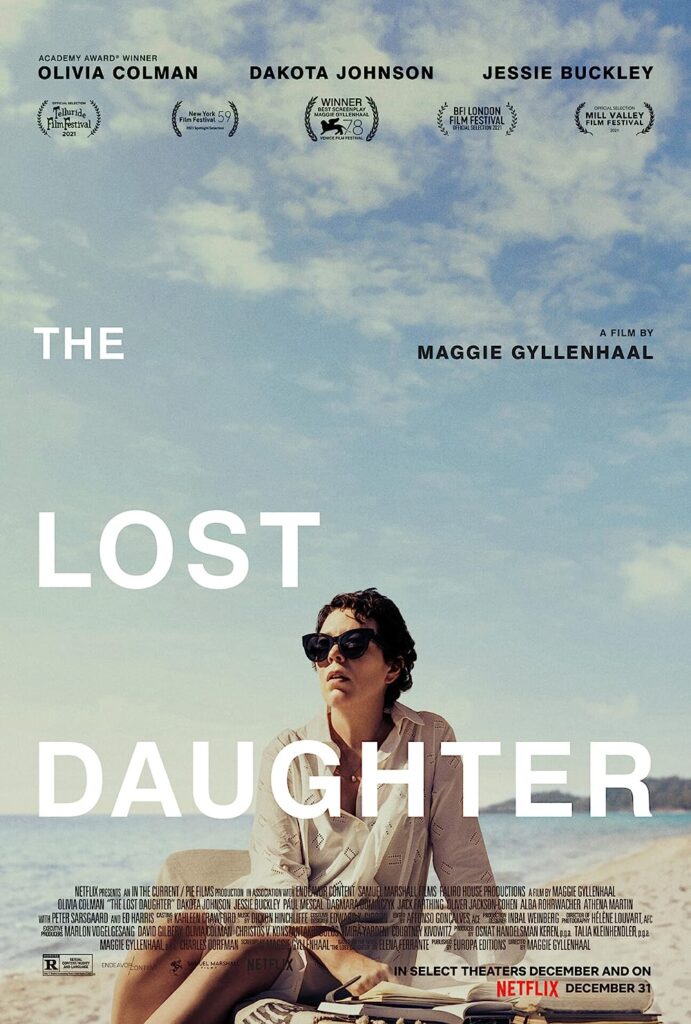
Elena Ferrante is one of my absolute favourite novelists. In my opinion, she is superior to all the big novel dudes (DFW, Karl Ove Knausgaard…) praised by all the lit-bros. Here characters are revelations of the complexity of what it means to be very real people in very real worlds fraught with very real dynamics related to class and gender and vulnerability and power. Honestly, other than urging people to read her writing (especially the Neapolitan Quartet), I usually feel at a loss for words when it comes to trying to convey what she accomplishes.
So, it’s a bold move for Maggie Gyllenhaal to adapt one of Ferrante’s stories to film. And, in fact, it’s one that I believe Gyllenhaal accomplishes—with the support of a very strong and capable cast of female actors. The Lost Daughter powerfully blends the dreadful and the mundane, the devastating and the this-happens-every-day, the unacceptable and the this-is-totally-fine. People hurt people, people survive being hurt, people do selfish things, people just want to be happy, people feel stuck, freedom might be worse. And apart from a tree dropping pinecones that wound, nobody here can cast any stones.
Provocative and uncomfortable—but not in ways you might expect—I’d like to hear what others think of this one.
Documentaries
Bustnes, Håvard. Golden Dawn Girls (2017).
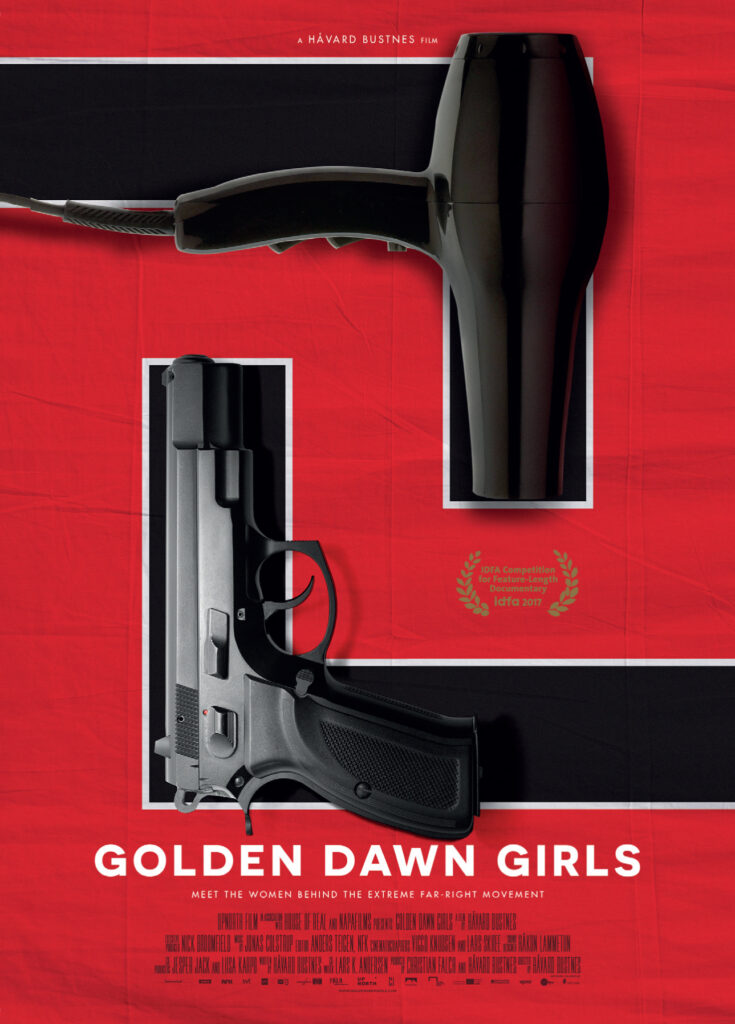
I’m cautious of reporters or documentarians who want to explore “the human side” of members of violent hate groups like White supremacists, neo-Nazis, or fascist groups like Greece’s Golden Dawn. All too often, these pieces end up serving the ends of the groups that are studied. They can inadvertently (or not) become useful propaganda for the haters who then can say, “look, we’re just people like everyone else, caring for our kids, working hard jobs, struggling to survive austerity, inspired by the faith of our ancestors,” and so on. So I wasn’t sure what I would get when I watched Håvard Bustnes’s documentary on the women of Golden Dawn (who ended up being the main leaders of Golden Dawn when the main male leaders—their husbands, brothers, and sons—were jailed). All in all though, I think Bustnes did a good job. He didn`t present Golden Dawn as one perspective amongst others, he problematized the claims they made about themselves, he pointed out when they were telling lies, and he even challenged some of them to their faces and voiced his disagreement. This is how journalism should be done in relation to parties like these. Not a platform for their views, but an inside look that makes it clear just who we are all dealing with here. Know your enemies so you will not be fooled by them. Know your enemies so that you can understand that, despite their family values and their woes, they are your enemies.
Cooper, Emma. Depp v. Heard (2023).
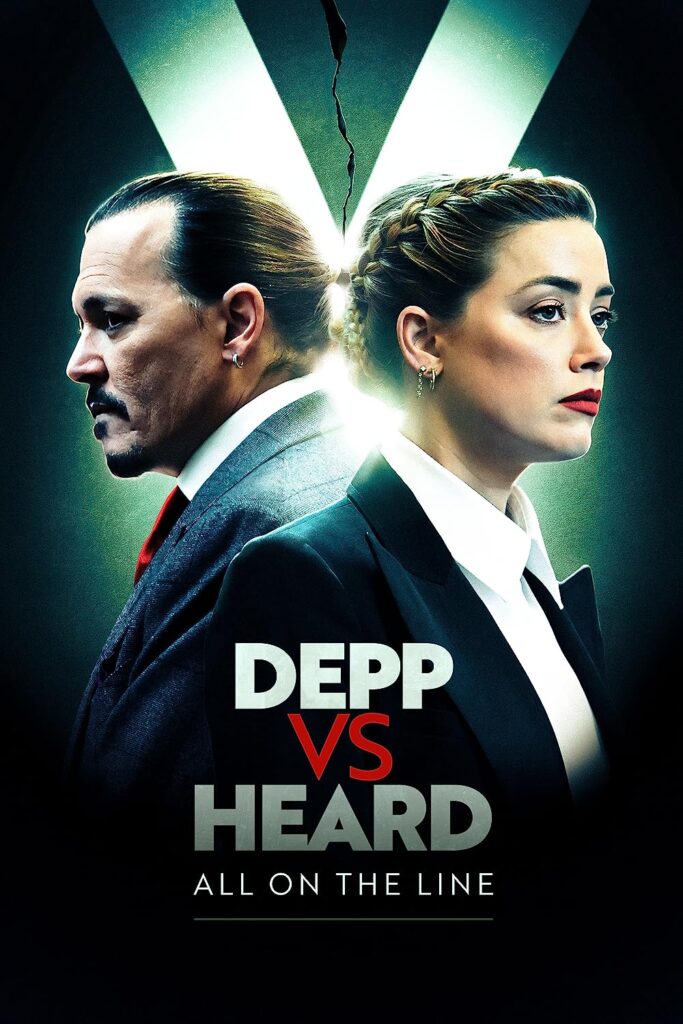
Stringing together trial footage, news reports, youtube commentators, and tiktok videos, and arranging them in chronological order, briefly touching on critical issues but never going too deep or offering any critical analysis, may bring in viewers who are attracted to the spectacle of charismatic abusers and the women they attempt to utterly destroy, but it sure left me feeling dissatisfied with this three-part docuseries. Attempting to present the information as a neutral third party, as Cooper seems to do, also wears thin in the context of brutality. Bustnes documentary about the women involved with Golden Dawn does a much better job of not dehumanizing people just because they revel in violence or desire monstrous things, while also being clear that there is no support or justification for their pursuits. This documentary was a real wasted opportunity. It would have been far better to explore in depth a few things that are only briefly mentioned (how rape culture requires survivors to be perfect victims otherwise they are discounted or also labeled abusers, how very well-funded and prolific bot accounts were instrumental in shaping the online misogyny, how this fostered a whole cultural mobilization of misogyny [which, according to Kate Manne’s excellent definition, is the enforcement side of patriarchy which punishes women who deviate from patriarchal norms and protocols], and about the pettiness of cruel and powerful men [I mean, shit, Depp never once looked at Heard during the trial because when they were breaking up he told her, “you will never see these eyes again” and he followed through on that promise… which basically tells you everything you need to know about Depp]).
Al-Kataeb, Waad and Edward Watts. For Sama (2019).

As I am late writing this review, it is impossible to not think about the genocide Israel is committing in Palestine as I reflect on the footage captured by Waad Al-Kataeb during the Syrian uprising against dictatorial power that took place in Aleppo. The madness of power, the cruelty of wealthy people, the utter barbarism and insanity of wars waged against the poor, oppressed, and colonized—all these things are on full display here. Al-Kataeb’s camera does not flinch. Nor should it. And it also does not miss the exuberance of the human spirit, the joyfulness of liberation (even if ever only for a moment), the deep bonds of affection that exist between parents children, friends and neighbours, and those who are united in a cause much greater than each individual. If you watch this, your heart will swell with love and then utterly shatter along with the lives of the children killed as bombs fell on their homes, their heads, their hospitals (as Israeli bombs now fall on Gaza). Little people are so full of love. Big people are so full of greed that they do not understand love. This is not just the story of Aleppo. This is also the story of Gaza. And of the Canadian occupation of Turtle Island. And of the neoliberal colonization of the globe. What lessens await those of us with love and hope in our hearts? The same lessons that awaited Waad Al-Kataeb. Evil is every stronger and more ruthless and more well-funded than good. Fight or don’t fight. Run or don’t run. Surrender or don’t surrender. Die or don’t die. One way or another, we still have to try and find ways to love each other while we still can.